Karnataka: political history
(→The Scheduled Caste vote) |
|||
| Line 71: | Line 71: | ||
Z Generation Z’s oldest members vote in their first poll as they turn 18 — 15L first time voters this time | Z Generation Z’s oldest members vote in their first poll as they turn 18 — 15L first time voters this time | ||
| − | |||
| − | |||
| − | |||
| − | |||
| − | |||
| − | |||
| − | |||
| − | |||
| − | |||
| − | |||
| − | |||
| − | |||
| − | |||
| − | |||
| − | |||
| − | |||
| − | |||
| − | |||
| − | |||
| − | |||
| − | |||
=Caste= | =Caste= | ||
Revision as of 20:44, 28 April 2018
This is a collection of articles archived for the excellence of their content. |
Contents |
Assembly elections
The issues in the 2018 Assembly elections
Ahinda To Gen Z, All You Need To Know About The K’taka Poll, April 22, 2018: The Times of India
What will decide the vote in Karnataka, the last among large states with Congress at the helm? Will the SC/ST Act’s dilution impact polls, will CM Siddaramaiah’s regionalism pitch help him or is anti-incumbency too strong? The A to Z in the run-up to the southern state’s 14th election to its 224-seat House — current House has 122 Cong MLAs and 40 each of BJP and JD(S)
A HINDA The backbone and heart of Congress chief minster Siddaramaiah’s welfare schemes, on the lines of those running in neighbouring Tamil Nadu as well. Ahinda is a Kannada acronym for alpasankhyataru (minorities), hindulidavaru mattu (backward classes) and dalitaru (Dalits). Congress’s key poll plank to retain state
BANGALORE REGION: One of the state’s six regions, Bengaluru has been traditionally BJP turf. Winning margins here were the highest on average in 2013. There’s anger over tawdry infra and Siddaramaiah government’s failure to nab anti-Hindutva activist Gauri Lankesh’s killers and rationalist MM Kalburgi’s murderers
CASTE: Over 60% of the 6.5cr population are minorities, OBCs, SCs and STs
17-19% Upper caste Lingayats (BS Yedyurappa, BJP) (Influence 120 seats) 17% Dalits + SCs (Mallikarjun Kharge, Leader of Congress in Lok Sabha) (Influence 100 seats) 12-14% Upper caste Vokkaligas (Deve Gowda, JDS chief) (Influence 67 seats) 12.5% Muslims (Influence 66 seats) 8% OBC Kuruba (Cong CM Siddaramaiah) 7% Tribal (ST) 2% Other upper castes 2% Christians 30% Other OBCs
DALITS: Anger over the Centre’s feeble response to Supreme Court’s watering down of provisions in the SC/ST Atrocities Act is palpable. Union minister Ananthkumar Hegde’s statement that “Constitution needs to be changed time to time” also has been read as the NDA govt’s call against reservation
EMERGENCY YEARS: This was the period when the Ahinda outreach strategy was first used by Indira Gandhi-loyalist Devaraj Urs, the only K’taka CM to beat anti-incumbency against a powerful Congress faction. Riding on the Ahinda vote, he returned as CM in the assembly election of 1977
FARM CRISIS: Disquiet is severe; the state has seen 3,515 farmer suicides from 2013 till 2017. About 56% of its people depend on agriculture for their livelihood and have suffered 13 droughts in the last 16 years — it’s the most arid state after Rajasthan
GRAFT: The mining Reddy brothers, two of whom were indicted by Lokayukta in a scam in 2011, are back with the saffrons — two of them even contesting, BJP’s anti-graft moral ground shaky in poll winds. Congress too is weighed down by graft charges and mega scam charges. A 2017 survey of 20 states by a non-profit CMS showed K’taka to be the most corrupt state in having to bribe for public services
HINDUTVA: Holding aloft the Hindutva flag, especially in coastal districts of Kodagu and Mysuru, are MLA CT Ravi, and MP Shobha Karandlaje and Union minister Ananthkumar Hegde while CM-nominee B S Yeddyurappa canvasses as a farmers’ leader
INDEX: It’s India’s third fastest growing state. Bengaluru accounts for almost half the state’s GDP but K’taka is among middling states on social development parameters of health and education
JANATA DAL (SECULAR): JD(S) founder Deve Gowda hopes to play kingmaker in this do-or-die battle where father and son, one-time CM HD Kumaraswamy, have rejected alliances with BJP and Congress, but have been called “BJP’s B-team” by Rahul Gandhi. The Gowda clan is tipped to tap into the Dalit vote after a first-time tie-up with Mayawati — BSP will contest on 8 of the 36 SC seats
KANNADA IDENTITY: CM Siddaramaiah’s aggressive pitch for the primacy of Kannada over the north’s imposition of Hindi has won him fandom. In tandem with his government’s decision to adopt a separate flag for K’taka, his anti-Hindi measures were evident when Hindi signboards were removed from Metro stations
LINGAYATS: This upper caste forms the largest grouping, spread across north K’taka, influencing over half the seats. Traditionally BS Yeddyurappa loyalists, their man is on the backfoot handling Siddaramaiah’s move promising to declare Lingayats a religious minority; 48 of 218 Congress nominees are Lingayats
MUTTS: Multiple religious sects influence wide swathes and small clusters. Hence, Amit Shah’s visit of 43 mutts the moment he hit the campaign trail and Rahul Gandhi’s similar temple run of at least 20 shrines
NAMO EFFECT: The Modi wave won BJP 17 of Karnataka’s 28 Lok Sabha seats in 2014 but Congress still managed a 41% voteshare. Namo effect is on test here, given the state is the biggest of the four that Congress holds and the party has rarely gone below a 35% voteshare across elections
OOPS! Amit Shah’s campaign began on a shaky note with back-to-back faux pas. First, the saffron chief blurted that the most corrupt government had been their own man BSY’s. The second howler was when Shah’s translator goofed up saying PM Modi will do nothing for the poor. In a third slip, his garland for poet-philosopher Basavanna missed its target
POLITICS WITHIN: CM Siddaramaiah is for all purposes the heavyweight helming the campaign, but some reports suggest Dalit leader and Lok Sabha MP Mallikarjun Kharge may well be eyeing the CM’s post as well
QUOTA: A poll issue that could impact about 50 seats that were won with narrow margins in 2013. Karnataka government passed a bill for SC/ST reservation in promotion in govt jobs, side-stepping an SC order that had shot down the move. One camp is resisting the bill while associations of backward classes and minorities are pushing the Congress govt to notify the seniority list
REGIONALISM: In 2013, 20th century thinker-poet Kuvempu’s poem was declared K’taka’s state anthem. Kuvempu along with 12th century social reformer Basava are the “double helix of (Kannada) cultural DNA,” the CM said. Add to that his pitch that the South subsidises the North. Congress hopes the regionalism card will fetch it votes of Telugu, Tamil and Malayalam-speaking Bengalureans, about 30% of the city
SIDDARAMAIAH: He’s the only CM in K’taka to serve a full 5-year term in the last 40 years, claims he has delivered on 156 of 165 poll promises. Faces strong anti-incumbency, charges of corruption and criticism over his failure to fix Bengaluru’s infra and pollution problems
TAINTED NOMINEES: There’s no getting away from parties fielding tainted nominees, backers vouching for their ‘winnability’. All parties have significant numbers of allegedly corrupt nominees
UNIFICATION of the Kodagu and Kannada-speaking parts of the erstwhile provinces of Bombay, Madras and Hyderabad with the old Mysore state, under the States Reorganisation Act of 1956, formed the new state of Mysore. The state was renamed Karnataka in 1973
VERDICT: The Mecca Masjid verdict acquitting terror-accused Aseemanand is poll fodder with BJP chief Amit Shah targeting Congress over its ‘saffron terror’ comments
WATER SHARING: Sharing of Cauvery waters settled for now, farmers protesting over sharing of Mahadayi river waters with Goa, went on a 900-day-plus dharna in north Karnataka. Buoyed by Yeddyurappa’s claim that Goa CM Parrikar had promised to share Mahadayi’s waters, the stir shifted to Bengaluru BJP office in December 2017. But the claim fell flat, leaving farmers furious
X-FACTOR: This in reality the ex-factor with all parties leaning on old, reliable faces. Congress, for one, has repeated most of its candidates
YEDDYURAPPA: The return of the ex-CM to BJP has invigorated the saffron camp. BJP’s defeat in 2013 in the state was put down to the Lingayat neta’s exit from the party
Z Generation Z’s oldest members vote in their first poll as they turn 18 — 15L first time voters this time
Caste
Smaller OBC votes can swing battles in K'taka
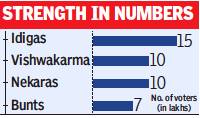
From: ManuAiyappa Kanathanda, How smaller OBC votes can swing big battles, April 28, 2018: The Times of India
Small is big for Karnataka polls as winning margins become increasingly slender. It explains parties’ focus on 200-odd smaller castes within Other Backward Classes (OBCs) that could make a difference in several seats.
In fact, the ‘other’ OBCs were key to the rise of Siddaramaiah as an Ahinda leader. OBCs in Karnataka are a motley category of 207 castes, including Vokkaligas, Kurubas and the OBC section of the numerically dominant Lingayats.
‘Other’ OBCs may not be individually significant but together make up a crucial chunk of votes. The Idigas, Nekaras, Vishwakarmas, Gollas, Upparas, Madivalas, Kumabaras, Tigalas, Savitas, Marathas, Kolis, Namdhari Reddys, Bunts and Kodavas are prominent among them.
“The smaller OBCs have voted differently in each assembly poll; so, it is difficult to predict their thinking,” says N Shankaranna, a backward class leader.
Idigas hold the key in several Dakshina Kannada, Shivamogga and Kalaburagi seats while Nekaras are significant in the north.
With all three parties enjoying the support of dominant castes, the votes of the numerically smaller groups will come into play, added Shankaranna.
State flag
The demand, in brief
Johnson T A, July 19, 2017: The Indian Express
Why the flag of Kannada pride has triggered a row
A longstanding demand by Kannada activists for an official state flag exploded into a major controversy on Tuesday, triggering allegations of subverting the Tricolour, and playing the political field ahead of Assembly elections. While Chief Minister Siddaramaiah maintained that nothing unconstitutional was afoot and dared the BJP to publicly reject the demand for an official flag for Karnataka, lost in the political noise were the realities of Kannada subnationalism, and the distinction, articulated by a Home Ministry official in New Delhi, between the “people” and the “state”.
The background
In 2014, Patil Puttappa, a 96-year-old veteran journalist and Kannada activist, and Bheemappa Gundappa, a 56-year-old RTI activist, made a demand for an official flag for Karnataka. On June 6 this year, the Kannada and Culture Department of the state government notified the setting up of a nine-member committee to examine the feasibility and legal issues around the demand. The matter had been reported in the local media at the time, but it was picked up again, and projected as an effort by Karnataka’s Congress government to subvert the national flag and the laws that allow only Jammu and Kashmir to have its own flag. Attack, counterattack BJP MP Shobha Karandlaje alleged the government was “going against the nation” by setting up the committee to look into the demand for a state flag. BJP leaders alleged that the Congress was trying to whip up Kannada pride ahead of the 2018 elections. Janata Dal (Secular) leader H D Kumaraswamy said there is no provision in the Constitution for a state flag. “The Congress government is using this issue to divert attention from some recent controversies,” he said.
Chief Minister Siddaramaiah, who has often sided with pro-Kannada activists on issues of local pride, rejected the allegations. “We have constituted a committee to look at the issues in the creation of a state flag. Based on the recommendations of the committee we will take a decision. Karnataka already has an official state song and there is a feeling that there is nothing wrong in having a state flag,” he said. “Having a state flag will not disrupt the unity and integrity of the country and will not reduce the stature of the national flag,” the Chief Minister added. “The national flag will always fly higher that the state flag, there are no two ways about it. Most importantly, the Constitution of India does not ban such flags,” he said.
“An attempt has been made to create a controversy. It is wrong of BJP leaders to spread misinformation. Let them state publicly that there is no need for an official flag for Karnataka. The committee has not been constituted with the Assembly elections in mind. The polls are scheduled only for May next year,” Siddaramaiah said. The committee is yet to meet to discuss the issue, said G S Siddaramayya, chairman of the Kannada Development Authority, who is part of the nine-member panel. In New Delhi, however, the leadership of Siddaramaiah’s own party betrayed nervousness at the turn of events. Sources in the Congress said the party high command felt the issue could be used by the BJP to attack it. It was “out of the question” for the Congress to accept a separate flag, a senior leader said. AICC general secretary in charge of Karnataka, K C Venugopal, said: “The Chief Minister has already given a clarification. They have not decided anything. The Culture Department of the state has set up the panel. It is not at the Chief Minister’s level. The committee will see whether the demand is admissible… legal points have to be looked into… The BJP wants to create a problem.”
A flag since the 60s
Incidentally, Karnataka has had an unofficial state flag since the mid 1960s when pro-Kannada groups were agitating against the screening of non-Kannada films in the state. The red and yellow flag was created by Kannada writer and activist Ma Ramamurthy for a pro-Kannada political party called the Kannada Paksha, after he observed that many parties representing non-Kannadigas had flags of their own. This unofficial flag is flown every year on November 1, Karnataka’s foundation day, and is a common sight at public places. Pro-Kannada activists have virtually adopted the red and yellow flag as a symbol of state pride. During agitations and protests like those over the sharing of Cauvery water with Tamil Nadu, the red and yellow banner often serves as protection against attacks by mobs — and private vehicles fly the flag in an attempt at ensuring safe passage for themselves. BJP flip-flop
In 2012, Karnataka’s BJP government accorded official status to the Karnataka flag through a notification. Chief Minister D V Sadananda Gowda said in his 2012 Budget speech that it would be compulsory to hoist the state flag on government buildings, schools and colleges. However, Kannada activist Prakash Shetty went to the High Court saying that rival activist T A Narayana Gowda was misusing the state flag for personal gain. During the hearing of the case, the then Chief Justice of Karnataka High Court, Vikramajit Sen, raised questions on the legality of states having their own flags when the law permitted only the national flag to be flown officially. The government then said it would not make it mandatory to fly the state flag. Eventually, on October 4, 2012, it withdrew the notification ordering the hoisting of the Kannada flag on government offices on November 1. People and state
In New Delhi, a Home Ministry official told reporters that “We are one nation, one flag”, but “legally, there is no provision either for providing or prohibiting a separate flag for any state”. This issue had been raised earlier too, but such a flag only represents “the people and not the state”, the official said. The Kannada flag was not raised on Republic Day or Independence Day, but on occasions like the state’s foundation day, Ministry sources noted.
February 2018/ Karnataka’s State Flag proposal
February 8, 2018: The Indian Express
If adopted with clearance from the MHA, Karnataka will be the second state after Jammu and Kashmir to have an official state flag. Karnataka has had an unofficial state flag since the mid-1960s, used to signify local pride.
A committee constituted last June by the Kannada and Culture department of the Karnataka government to examine the feasibility of having a separate flag for the state has submitted its report, recommending an official three-coloured flag to replace an unofficial two-coloured one currently used to signify local pride.
Led by chairman of Kannada Development Authority G S Siddaramaya, the nine-member committee has recommended a flag with the yellow and red of the unofficial flag to be separated by white in the middle with the state symbol on it.
Karnataka Chief Minister Siddaramaiah said the issue will be put up for consideration by the state cabinet before it is forwarded to the Union Ministry of Home Affairs (MHA) for clearance.
The recommendation for an official flag for the state has not, however, been well-received by a few leaders of pro-Kannada groups who have built an identity by working under the banner of the unofficial red and yellow flag.
“The colors recommended for the flag by the panel is not representative of the state. We will oppose this flag if the state government accepts the recommendation,’’ veteran pro-Kannada activist Vatal Nagaraj has stated. If adopted with clearance from the MHA, Karnataka will be the second state after Jammu and Kashmir to have an official state flag.
Karnataka has had an unofficial state flag since the mid-1960s, when pro-Kannada groups, including Nagaraj’s, were agitating against screening of non-Kannada films in the state. The red-yellow flag was created by Kannada writer and activist Ma Ramamurthy for a pro-Kannada political party called the Kannada Paksha. This unofficial flag is flown every year on November 1, Karnataka’s foundation day, and is a common sight at public spaces in the state.
2018: Clearance by the cabinet
Chethan Kumar, March 8, 2018: The Times of India
It's almost official now. The proposed yellow-white-and-red flag with the state’s symbol "Gandaberunda" at the centre was formally unveiled by Chief Minister Siddaramaiah, whose cabinet is likely to clear the proposal to have a separate flag for Karnataka later in the day.
A nine-member committee had in February submitted a favourable report recommending such a flag for the state nearly nine months after it was constituted. TOI was the first to report that the proposed flag will be a Tricolour and that it would be of yellow, white and red colours, and the government on Wednesday confirmed the same design.
Officials said that the committee was of the opinion that white, symbolising peace, captures Karnataka’s image best along with the two other two colours that have become synonymous with the Kannada identity.
Another official said that the government — after the Cabinet approval — will be writing to the Ministry of Home Affairs (MHA) seeking an amendment to the Flag Code, 2002. “The government will be seeking an amendment to enable provisions of including the Karnataka flag also as one of the symbols in the Flag Code,” the official said.
If the Centre does consider and give its nod for the said amendment, Karnataka will only be the second state in the country to have its own flag after Jammu and Kashmir, which is allowed to have a symbol under Article 370 of the Constitution.
An MHA official from Delhi had told TOI earlier that while there is no provision allowing or disallowing such a flag, there has been no precedence.
“I think the issue is quite serious and it will be seriously examined by the (Union) government. A thorough examination will be required to see what kind of precedent this would set. Also, nuances like what would be the protocol and code for the flag among other issues,” he had said.
Presently, the Flag Code recognises only one flag—the Tricolour—and has rules citizens and organisations must follow to maintain its dignity. If there is an amendment made to accommodate Karnataka’s proposed flag, it will be for the first time that such a symbol has been added to the Code and may pave way for other states to also propose similar symbols in the future.
Voting pattern
2008, 2013, 2014: Congress vs. BJP
March 28, 2018: The Times of India
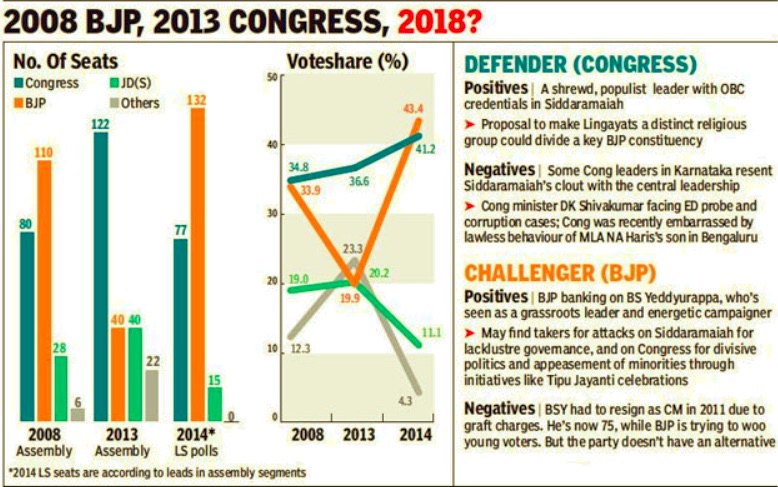
From: March 28, 2018: The Times of India
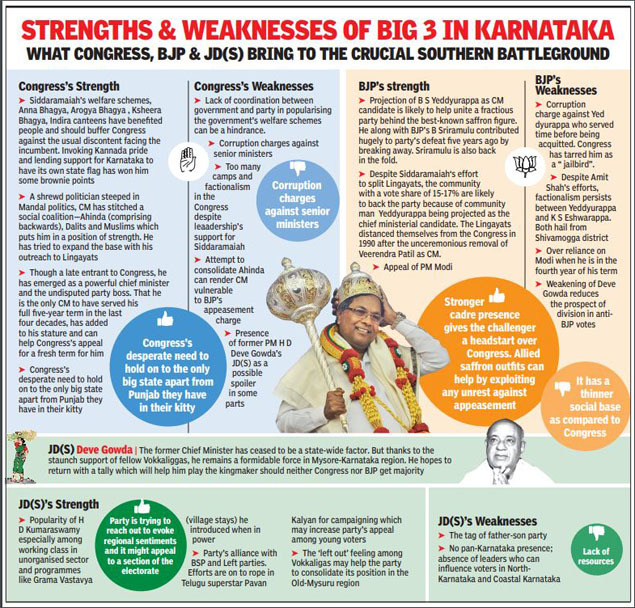
From: March 28, 2018: The Times of India

From: March 28, 2018: The Times of India
HIGHLIGHTS
Retaining Karnataka is crucial to Congress's claim to being the main anti-BJP force for the 2019 Lok Sabha polls.
BJP needs a win to regain the momentum it lost after SP and BSP came together to win two prestigious UP bypolls.
The Karnataka poll — the results of which will be announced on May 15 — is already heated with BJP and Congress keenly aware of the importance of the prize: A loss will rob Congress of one of two major states in which it is still in office while BJP needs a win to regain the momentum it lost after SP and BSP came together to win two prestigious UP bypolls despite a saffron victory in Tripura.
2013 (Assembly), 2014 (Parliament)
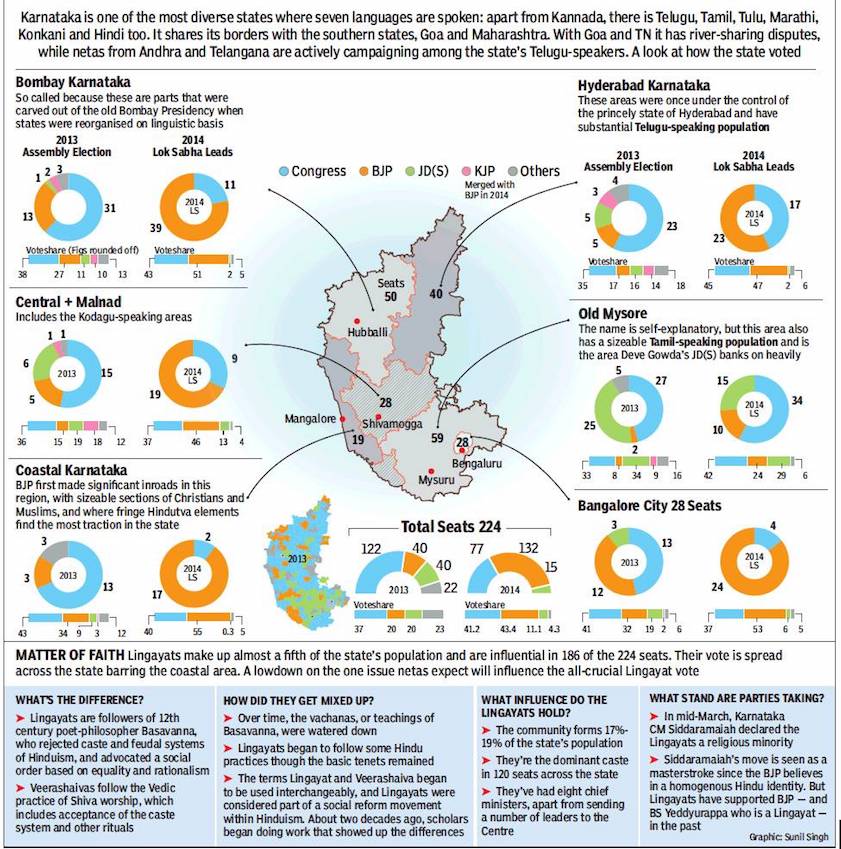
From: April 21, 2018: The Times of India
See graphic:
The pattern of voting in Karnataka in the elections of 2013 (Assembly) and 2014 (Parliament)
2018
Some Vokkaligas angry with Congress, CM Siddaramaiah
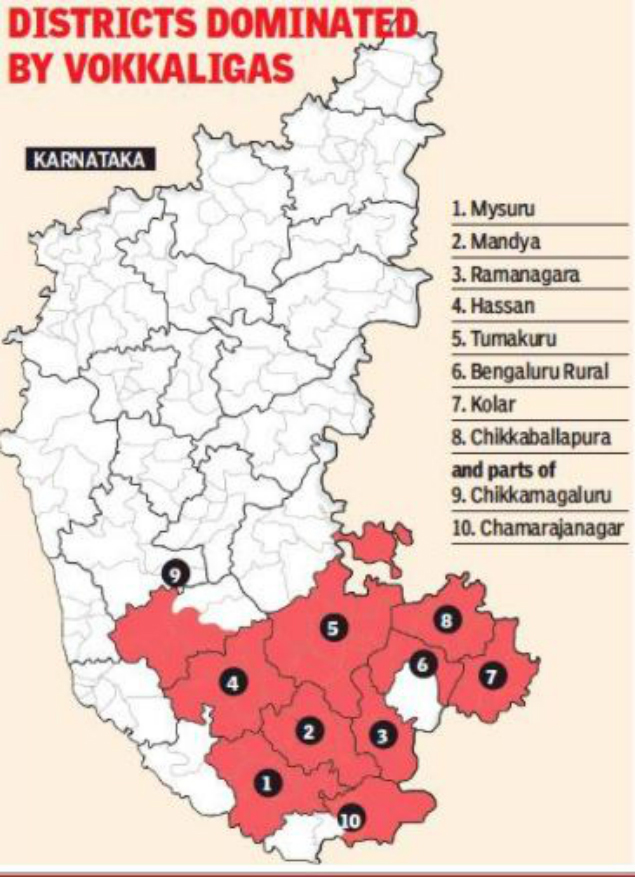
From: Karnataka election 2018 :Why are Vokkaligas angry with Siddaramaiah?, April 11, 2018: The Times of India
HIGHLIGHTS
Vokkaliga passions are running uncharacteristically high against Siddaramaiah in the run up to the May 12 polls.
The epicentre of this Vokkaliga consolidation against Siddaramaiah is Chamundeshwari — his own assembly constituency in Mysuru district.
Not all Vokkaligas are against the Congress, and yet chief minister Siddaramaiah remains nervous. The reason: Vokkaliga passions are running uncharacteristically high against him in the run up to the May 12 polls.
The epicentre of this Vokkaliga consolidation against Siddaramaiah is Chamundeshwari — his own assembly constituency in Mysuru district. Not wanting to be pulled down by the Vokkaliga tide, Siddaramaiah is exploring other political options: One, consolidate the non-Vokkaliga votes in Chamundeshwari and two, contest from another safe seat in North Karnataka.
The big question though is why Vokkaligas (a dominant caste of South Karnataka which forms around 8% of the state’s population) are against Siddaramaiah?
“It is because Siddaramaiah’s words and deeds has jolted the community. Vokkaliga consolidation is a new phenomenon happening in this election,” said political analyst Muzaffar H Assadi. Although several factors are at play, one reason for the anti-Siddaramaiah sentiment is his call to end the political hegemony of former Prime Minister H D Deve Gowda. The JD(S) supremo is one of the most respected leaders of the community.
“The JD(S) has used Siddaramaiah’s political call to consolidate the Vokkaliga votebank,” Assadi said. “Anyone who is opposed to Deve Gowda and (his son) Kumaraswamy are dubbed adversaries of Vokkaligas. So Vokkaligas are coming together to teach Siddaramaiah a lesson.”
However, the hostility has been gradually building up ever since Siddaramaiah was made chief minister. Political dynamics in the rural setup changed after Siddaramaiah covertly began politically empowering members from his Kuruba community.
“Political disruptions were engineered to strip Vokkaliga leaders of power in cooperative societies and panchayat raj institutions,” BJP spokesperson A H Anand said.
Changes in the reservation matrix in the last five years ensured more Kuruba community members came onboard the managements of cooperative societies, agricultural produce marketing committees (APMCs), taluk and zilla panchayats, primary land development banks and district cooperative banks. “While Vokkaligas fought elections and won, the Siddaramaiah government paradropped Kuruba community members through official nominations,” said a revenue official in Mandya district.
Vokkaligas also feel they have been sidelined because of Siddaramaiah’s vindictive politics. “Be it IAS or KAS, not a single Vokkaliga officer was given a good executive posting in old Mysuru districts during Siddaramaiah’s tenure. On the other hand, members from the Kuruba community were promoted and placed in coveted posts in various levels of administration. Casteism worsened in the bureaucracy during Siddaramaiah’s regime,” a recently retired IAS officer said. “The CM’s body language towards Vokkaliga officers was always different, smacking of arrogance.”
Siddaramaiah’s stance with regard to reservation in promotions for government officials also angered Vokkaliga officials. “Siddaramaiah and his people made it clear that they wanted to control all instruments of power,” the retired officer said. “In fact, the promotion list of KAS officers (who would be given IAS) was kept on hold for more than a year as two officials from the Kuruba community had to be accommodated. On promotion, a Kuruba KAS community officer was made the deputy commissioner of Bengaluru Urban district. It was the same with IPS officers.”